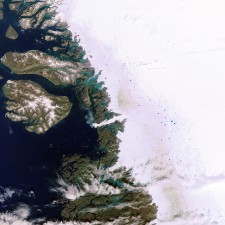Greenland
A Wild Card
Greenland is a source of major uncertainty in projections of global sea level rise over the coming decades and centuries. The largest island in the world, it contains enough grounded ice to raise global mean sea level by roughly seven meters, if it were to melt entirely—with world-wide impacts. Although experts think this is unlikely, recent observations of unexpected accelerating, thinning, and retreating of glaciers near Greenland’s marine margins have raised concerns.
The Ocean as a Trigger of Melting
An obvious mechanism for Greenland ice sheet melt is polar-amplified warming and resulting surface melting. This leads to extended melt areas, reduced snow cover, and changed ice micro-structure, all acting to reduce Greenland’s reflectivity, thus accelerating warming.
The greatest changes are being observed near Greenland’s marine margins, where fjord-terminating glaciers are undergoing much larger changes than land-terminating glaciers. This suggests that the ocean may be a dominant trigger, which is consistent with observed shifts in the circulation of the North Atlantic’s subpolar gyre in concert with decadal changes in the atmospheric circulation. Warmer waters of subtropical origin may have been brought in to contact with the ice sheet through the network of fjords that connect the glacier termini to the continental shelves of the open ocean.
Greenland also sits between several crucial sites of oceanic deep convection, the Labrador Sea to its west, and the Greenland-Iceland-Scotland and Irminger Seas to its east. Deep waters formed in these areas are the source waters for ventilating the deep ocean, transporting with them atmospheric trace gases, such as CO2 or CFCs. An open question is whether increased ice sheet melt might freshen these regions sufficiently, inhibiting convection and affecting equator-to-pole heat transport.
Key Questions We’re Exploring
- Why didn’t the Greenland ice sheet melt as part of the deglaciation after the Last Glacial Maximum? How stable is it now? How has its ice volume changed during glacial-interglacial cycles?
- What is causing the changes observed at Greenland’s marine margins over the last two decades?
- Can engineering provide new technologies to measure and monitor critical properties of ice sheets and ice sheet-ocean margins that are currently inaccessible?
- How can we best observe and model the interaction of ice sheets with ocean circulation?







